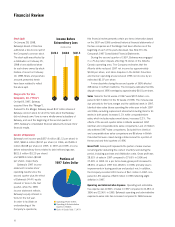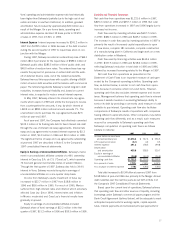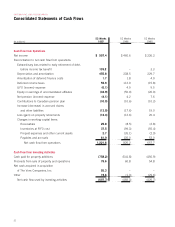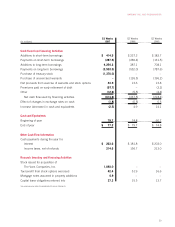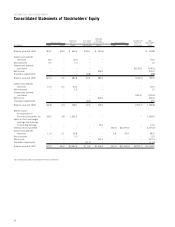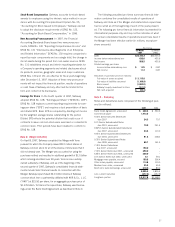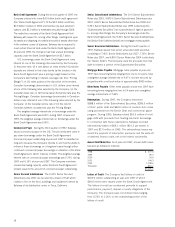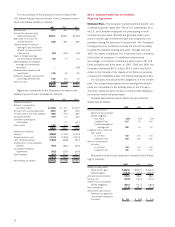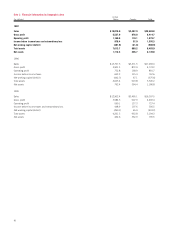Safeway 1997 Annual Report Download - page 29
Download and view the complete annual report
Please find page 29 of the 1997 Safeway annual report below. You can navigate through the pages in the report by either clicking on the pages listed below, or by using the keyword search tool below to find specific information within the annual report.
Goodwill Goodwill is amortized on a straight-line basis over
40 years. Goodwill amortization was $41.8 million in 1997 and
$10.4 million in both 1996 and 1995. Goodwill amortization
increased in 1997 due to the Merger with Vons, discussed
in Note B.
Self-insurance The Company is primarily self-insured for workers’
compensation, automobile, and general liability costs. The self-
insurance liability is determined actuarially, based on claims filed
and an estimate of claims incurred but not yet reported. The pre-
sent value of such claims was accrued using a discount rate of
5.5% in both 1997 and 1996. The current portion of the self-
insurance liability of $96.3 million at year-end 1997 and $65.1
million at year-end 1996 is included in other accrued liabilities in
the consolidated balance sheets. The long-term portion of $230.7
million at year-end 1997 and $168.7 million at year-end 1996 is
included in accrued claims and other liabilities. Claims payments
were $100.0 million in 1997, $66.7 million in 1996 and $71.4
million in 1995. The total undiscounted liability was $365.5 mil-
lion at year-end 1997 and $265.8 million at year-end 1996.
Income Taxes The Company provides a deferred tax expense or
benefit equal to the change in the deferred tax liability during
the year in accordance with Statement of Financial Accounting
Standards (“SFAS”) No. 109, “Accounting for Income Taxes.”
Deferred income taxes represent tax credit carryforwards and
future net tax effects resulting from temporary differences
between the financial statement and tax basis of assets and
liabilities using enacted tax rates in effect for the year in which
the differences are expected to reverse.
Statement of Cash Flows Short-term investments with original
maturities of less than three months are considered to be cash
equivalents. Borrowings with original maturities of less than
three months are presented net of related repayments.
Off-Balance Sheet Financial Instruments As discussed in Note E,
the Company has entered into interest rate swap and cap agree-
ments to limit the exposure of its floating interest rate debt to
changes in market interest rates. Interest rate swap agreements
involve the exchange with a counterparty of fixed and floating
rate interest payments periodically over the life of the agreements
without exchange of the underlying notional principal amounts.
The differential to be paid or received is recognized over the life
of the agreements as an adjustment to interest expense.
Interest rate cap agreements lock in a maximum rate on a
notional principal amount by paying a fee to a counterparty in
exchange for the counterparty’s promise to pay to Safeway the
difference between a fixed rate and a floating rate of interest.
The Company’s counterparties are major finan-
cial institutions.
Fair Value of Financial Instruments Generally accepted account-
ing principles require the disclosure of the fair value of certain
financial instruments, whether or not recognized in the balance
sheet, for which it is practicable to estimate fair value. Safeway
estimated the fair values presented below using appropriate
valuation methodologies and market information available as
of year-end. Considerable judgment is required to develop
estimates of fair value, and the estimates presented are not
necessarily indicative of the amounts that the Company could
realize in a current market exchange. The use of different
market assumptions or estimation methodologies could have
a material effect on the estimated fair values. Additionally, these
fair values were estimated at year-end, and current estimates of
fair value may differ significantly from the amounts presented.
The following methods and assumptions were used to estimate
the fair value of each class of financial instruments:
Cash and equivalents, accounts receivable, accounts payable
and short-term debt.
The carrying amount of these items approxi-
mates fair value.
Long-term debt.
Market values quoted on the New York Stock
Exchange are used to estimate the fair value of publicly traded
debt. To estimate the fair value of debt issues that are not quoted
on an exchange, the Company uses those interest rates that are
currently available to it for issuance of debt with similar terms
and remaining maturities. At year-end 1997, the estimated fair
value of debt was $3.2 billion compared to a carrying value of
$3.1 billion. At year-end 1996, the estimated fair value of debt
was $1.9 billion compared to a carrying value of $1.8 billion.
Off-balance sheet instruments.
The fair value of interest rate
swap and cap agreements is the amount at which they could
be settled based on estimates obtained from dealers. At year-
end 1997 and 1996, net unrealized losses on such agreements
were $0.4 million and $2.0 million. Since the Company intends
to hold these agreements as hedges for the term of the agree-
ments, the market risk associated with changes in interest rates
should not be significant.
Impairment of Long-Lived Assets In 1996, Safeway adopted the
provisions of SFAS No. 121, “Accounting for the Impairment of
Long-Lived Assets and for Long-Lived Assets to be Disposed of.”
SFAS No. 121 establishes recognition and measurement criteria
for impairment losses when the Company no longer expects to
recover the carrying value of a long-lived asset. Upon reaching
the decision to close a store or other facility, the Company
accrues estimated future losses, if any, which may include lease
payments or other costs of holding the facility, net of estimated
future income. As of year-end 1997, Safeway had an accrued
liability of $72.0 million for the anticipated future closure of 42
stores and $19.7 million for the anticipated future closure of
other facilities.
26


